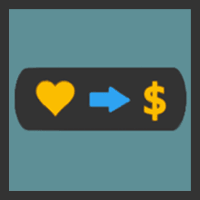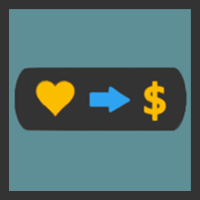Matthew Wayne Selznick's Blog, page 6
November 30, 2014
Pay What You Want: Month Two Report
November 25, 2014
Pay What You Want For A Five Song Collection
November 22, 2014
On “The Art of Asking” by Amanda Palmer
I don’t remember when musician Amanda Palmer first came to my attention, but I’ve known for years that our philosophies are very similar. In fact, until I became a patron of, and attended, her joint music and spoken word performance with author Neil Gaiman in 2011, I’d heard very little of her music. I knew and respected her solely from her online presence.
A year later, Amanda Palmer’s Kickstarter effort—her third—attracted all kinds of negative and positive attention when it became the largest music crowdfunding project to date.
In February of 2013, Amanda Palmer’s TED Talk, “The Art of Asking,” was released to the wider world. The talk, limited to twelve minutes or so, managed to wrap a message about music, neo-patronage, and the Internet economy around a characteristically personal and intimate autobiographical tale… and, in part, gave her an opportunity to counter some of the bad press she endured in the wake of her third Kickstarter and the subsequent tour.
That TED Talk speech, ultimately, made possible Amanda Palmer’s first traditionally published, mainstream book: The Art of Asking, or, How I Learned To Stop Worrying and Let People Help.
I have a strong positive bias when it comes to Amanda Palmer’s ethos. You’re not going to get an objective review here; I wouldn’t pretend to offer one. I loved this book.
Rather, this post is to explain why, if you’re a DIY, independent creator of any kind… indeed, an artist of any kind… you should probably read The Art of Asking.
A Literary Tone Poem On The DIY Ethic
 Like the best works of Gail Sher, Natalie Goldberg, or Philip Toshio, The Art of Asking is less a how-to book for creators, and more an object lesson on how one person has come to live a creative life.
Like the best works of Gail Sher, Natalie Goldberg, or Philip Toshio, The Art of Asking is less a how-to book for creators, and more an object lesson on how one person has come to live a creative life.
Long before I knew there was an Amanda Palmer in the world, I’d been spreading the message that creators and consumers must consider themselves part of an interdependent, peer-to-peer community with the swirling blend of the creator’s works and the consumer’s experience at the center.
Through carefully chosen, sometimes painfully personal, anecdotes from her own life and the lives of her closest friends, mentors, and family, Amanda Palmer demonstrates how that community coalesces, sustains itself, and grows.
She’s walked the walk of the Conversation-Age creative community member, a beneficiary and sponsor of neopatronage, on a path that, while uniquely her own, speaks to what’s possible for the rest of us.
The “how to,” put succinctly?
Be vulnerable, trust, give back… and ask.
Preconceptions and Reflections
I read, probably on Facebook but I can’t be sure and I’m not going to dig around for it, that whether you love or hate Amanda Palmer, The Art of Asking will reinforce your opinion.
I don’t know about that. Personally… and I write this from as objective a stance as I can manage… I think that anyone capable of empathy will be moved reading this book.
About a third of the way through, I stopped keeping track of the passages that brought me to tears.
Each time, my reaction was in response to shared human truths about expression, love, trust, and hope. Nothing to do with being a DIY, independent creator.
Okay. That’s everything to do with being a creator.
This is perhaps the pervasive lesson of The Art of Asking: the willing, bold experience of, and raw expression of, these difficult emotions brings us closer to our capacity to create, and to the people interested in our creations, and to ourselves.
Whether you consider yourself a creator, or a consumer of creative experiences, or, like most humans, a shifting combination of both, you’ll likely find inspiration and comfort in The Art of Asking by Amanda Palmer. You should read it!
Have You Read The Art of Asking?
I’d love to hear your thoughts, good or bad, regarding The Art of Asking, whether you consider yourself a DIY, independent creator or not.
Did the book change how you think about your relationship with creators, or with the people who experience your own creations?
Let’s talk about it in the comments!
The post On “The Art of Asking” by Amanda Palmer appeared first on Matthew Wayne Selznick.







November 13, 2014
An Open Letter To Daveyboy2, An Unauthorized File Sharer
 (A Note From Matt: A slightly different form of this letter first appeared as a comment to unauthorized file sharer Daveyboy2’s post on the unauthorized file sharing link repository site Mobilism.org. The moderators of that site were kind enough to remove Daveyboy2’s post at my request. As of November 13, 2014, I’m still waiting for replies to the DMCA notices I sent to the file sharing sites Daveyboy2 references in his (now deleted) post.)
(A Note From Matt: A slightly different form of this letter first appeared as a comment to unauthorized file sharer Daveyboy2’s post on the unauthorized file sharing link repository site Mobilism.org. The moderators of that site were kind enough to remove Daveyboy2’s post at my request. As of November 13, 2014, I’m still waiting for replies to the DMCA notices I sent to the file sharing sites Daveyboy2 references in his (now deleted) post.)
Hi, Daveyboy2.
My name’s Matthew Wayne Selznick. I’m the author of Brave Men Run and Pilgrimage.
I hope you enjoyed the books when (if?) you originally purchased them, Daveyboy2!
Since I mention this in each and every book I publish, you probably know that I provide my titles without any digital rights management restrictions.
I do this so that the person who buys my e-books can use them on any of their own devices, forever.
However, even though I don’t believe in punishing the owner of my e-books with DRM technology, that doesn’t mean my e-books are available for free to anyone.
I have never, ever offered my e-books for free.
Instead, I’ve tried to make sure my books are widely available in pretty much every major and minor online marketplace you can think of: Amazon, Barnes & Noble, Kobo, Smashwords, Scribd, and so on.
It’s not difficult to find my work, and my books are not unreasonably priced.
In fact, if you visit the shop on my site, you can pay what you want for everything I make… as little as a dollar, or as much as you want!
That includes Brave Men Run and Pilgrimage.
Given that my books are widely available, DRM-free, and super-affordable, I’m disappointed to see that you’ve posted unauthorized file sharing links to my works on mobilism.org.
Daveyboy2, I depend on sales of my creative works to help pay my bills every month. Some months, I have a pretty rough time paying those bills, believe me. You can see exactly what I make every month as a creative entrepreneur. I need every penny, no joke.
Making things for people is my job… including making books like the two you’ve shared without my authorization.
I know unauthorized file sharing of my work doesn’t actually steal from me. I’ve written about it (that link is in the two books you’re encouraging people to download without compensating me, by the way).
I’m writing this to simply let you know that I’m a person, just like you, and I’ve put a lot of time, effort, experience, and sacrifice into the books I’ve written.
So if you, or anyone else reading this, enjoyed Brave Men Run, Pilgrimage, or any of my other creative works without first compensating me, please head over to my shop and pay what you think those books are worth.
It makes a difference.
Thanks!
— Matthew Wayne Selznick
The post An Open Letter To Daveyboy2, An Unauthorized File Sharer appeared first on Matthew Wayne Selznick.







October 22, 2014
How I Set Up A Pay What You Want Website Store
 On October 7, 2014, I adopted a pay what you want pricing model for all of the creative endeavors I sell on this website. A week later, I revealed the reasons I’ve embraced this model.
On October 7, 2014, I adopted a pay what you want pricing model for all of the creative endeavors I sell on this website. A week later, I revealed the reasons I’ve embraced this model.
In this post, I’ll wrap up this trilogy and share with you the tools and other resources involved in making a pay what you want website… or any online store for independent authors or other creators.
The Platform
Just like fifty million other people, I use the free WordPress content management system from Automattic as the platform for this site. For the price, nothing beats WordPress when it comes to flexibility, stability, and extensive community-driven support.
While a shared website hosting solution like what’s offered by providers like Dreamhost (I’ve been a customer since 2007) is perfectly fine for most low-traffic sites of all kinds, I host my own site on a cloud server courtesy of the folks at Digital Ocean.
Hosting on my own server gives me a greater degree of control at the cost of requiring a bit more work and upkeep. It’s much like the difference between renting or owning your house.
If you’re planning on making the leap away from a free platform like Wix or Blogger to your very own site but you’re not technically savvy (or don’t have the time or inclination to learn), be aware that pretty much everything I’ve done to create this site can be done in a shared hosting (Dreamhost) environment.
Since this is a pay what you want website store and I know folks are concerned about e-commerce security, I’ve installed an SSL certificate from Comodo. This enables all information flowing to and from the site to be encrypted and safe from the inquisitive eyes of evil online robots.
The Look and Feel
WordPress uses themes to provide the look and feel of a site. If WordPress is the foundation and framing of the house, the theme is kind of like the paint job, the furniture, and maybe a little of the floorplan. I designed my own custom theme as a “child” (branch) of the Divi theme framework from ElegantThemes.
I built the site to look best at screen resolutions of 1024 pixels wide and larger, but since a historically small fraction of my site visitors view it on smaller phones and devices, the site also flows “responsively” to work well on smaller screens.
The design itself? What can I say… I like boxes. My previous design was boxy, too, but this time around I did away with most of the black borders to achieve something closer to the latest (as of this writing) “flat” user interface sensibilities.
Since I’m primarily a writer, and I want folks to read things on the site, I made sure the font was nice and big, too, with lots of open space. Here in my office, with a 24″ 1920×1080 monitor, I can comfortably read a blog post from five feet away! It makes my forty seven year old eyes happy.
The Shop
 After lots of experimentation with third party systems like Gumroad and other WordPress plugins like the excellent and versatile WP-eStore and, years ago, the now-defunct YAK, I finally bit the bullet and invested in WooCommerce for my pay what you want website shopping cart functionality.
After lots of experimentation with third party systems like Gumroad and other WordPress plugins like the excellent and versatile WP-eStore and, years ago, the now-defunct YAK, I finally bit the bullet and invested in WooCommerce for my pay what you want website shopping cart functionality.
WooCommerce is widely supported and frequently updated. It’s as close to a “standard” for shopping carts as one will find in the WordPress ecology.
While Woocommerce is itself free, the parent company makes its money selling add-ons (some might say essential add-ons!) to the core plug-in. For this site, that includes a plug-in that enables the pay what you want functionality itself.
Happily, many independent developers offer inexpensive (sometimes free!) plugins that work perfectly with WooCommerce, such as the one that allows folks to pay by credit card using Stripe instead of PayPal (some of you can’t or would rather not use PayPal, so I made sure to offer an alternative).
Marketing
When it comes to communicating with your community, marketing your creative work, and selling your creative work, nothing—nothing—is more important or effective than an email newsletter.
 I use MailChimp to manage my mailing list community. It’s free for basic use up to a certain number of subscribers, but I spring for some extra features like the ability to set up autoresponders.
I use MailChimp to manage my mailing list community. It’s free for basic use up to a certain number of subscribers, but I spring for some extra features like the ability to set up autoresponders.
As an incentive for people to subscribe to the mailing list and become part of the community, I offer a free ebook sampler of my novels, short stories, and non-fiction works to anyone who signs up.
Members of the mailing list community get exclusive content from me about once a month, and they’re usually the first to know about new stuff I have planned. I try to support them, as well, by spreading the word about their own creative endeavors and accomplishments.
That’s great… but the challenge remains to actually let people know the mailing list exists, and get them to sign up.
I used to have a persistent sign-up form in the sidebar of most pages of the site, but the unfortunate fact is that visitors quickly become acclimated (read: blind) to passive features on a site. Think about it: can you remember what was advertised at the top of the page the last time you visited YouTube?
There’s just one passive mailing list call to action on the site: front and center and above the fold on the home page.
Active calls to action are far more effective. I use a couple of offerings from AppSumo’s SumoMe plugin to create the pop-over and slide-in features you’ll see on most pages of this site (as well as the social sharing bar on the left side of every page). The SumoMe tools integrate seamlessly with MailChimp, automating everything from sign-up to delivery of the free ebook sampler.
Customer Service
I’m really, really big on the idea that creators and consumers are all part of the same community. I believe in direct communication and a high level of transparency between me and my friends and fans.
Additionally, a potential customer is much more likely to make a purchase if they can ask someone about a product right then and there. I love the idea that I could make myself available to answer questions about my creative endeavors in real time!
To that end, I’ve installed a free chat feature on the site, courtesy of the folks at Zopim. It’s that little blue prompt at the bottom left of nearly every page on the site… try it out! If I’m online, I’ll respond as quickly as possible to answer your questions.
If I’m not around, you can leave me an email message right there in the chat window!
Other Plugins and Tools
My pay what you want website depends on a few other essential tools:
Caching
Most content management systems depend on a database to, well, manage the content, and WordPress sites are no different. Put simply, every time you visit a page on a site, the server calls the database and asks for the content.
To reduce the amount of work that takes (and improve the overall speed of the site), it’s important to employ some kind of caching system that reduces the number of calls to the database by instead showing a visitor pre-saved versions of a page. Again, that’s putting it simply.
 For this pay what you want website, I’m using WP Rocket. While a relatively new offering in the WordPress caching plugin marketplace, I’ve impressed with its straightforward functionality and very impressed with the speed, friendliness, and quality of the support staff. They’ve earned their keep, and then some.
For this pay what you want website, I’m using WP Rocket. While a relatively new offering in the WordPress caching plugin marketplace, I’ve impressed with its straightforward functionality and very impressed with the speed, friendliness, and quality of the support staff. They’ve earned their keep, and then some.
Content Delivery Network
Often working hand-in-hand with a caching system, a content delivery network (CDN) uses distributed servers to send certain parts of a website, like images, faster than otherwise possible.
This is accomplished by delivering those assets from a server geographically closest to the website visitor’s actual location. If someone’s visiting a site from Southern California and the website’s home server is in London, doesn’t it make more sense for me to receive the largest assets (usually images) from a server located in Los Angeles rather than the UK?
My content delivery network of choice is MaxCDN.
Security
Earlier, I mentioned that WordPress enjoys an audience of users numbering in the tens of millions. That’s great, because that means there’s lots of help, information, and both formal and informal support out there.
The downside is that malicious entities on the web target sites running WordPress. They look for vulnerabilities—either weaknesses in the software itself, or flaws in the behavior of site owners—to exploit to spread viruses, malware, and other nastiness.
It’s an arms race, and the WordPress community does a fantastic job of keeping the barbarians at bay.
All the same, every website administrator (and if you’re in indie author or DIY creator with your own site, that’s probably you!) must be responsible for their own site. That’s where a security plugin comes into play.
I use iThemes Security Pro, which is a for-pay product. There are free options out there, but, similar to WP Rocket, I opted to pay for a solution that is both effective and easy to set up and maintain. Sometimes free products, while they often excel in function, lack in the user experience department.
Backups
The best security plugin on the market isn’t a 100% guarantee against trouble. Nothing is.
That’s why it’s important to have a backup system in place… especially for a pay what you want website that is a key component of my financial livelihood. I can’t afford to lose my data or be knocked off line by circumstances outside of my control.
I use BackupBuddy, another iThemes plugin. It’s set up to automatically create backups of my site and store them wherever I like.
Search Engine Optimization
The best way to be discovered by and rank highly on search engines is by presenting high quality content in a way that’s clear and well-organized.
You don’t necessarily need a special tool to accomplish that… but when there’s a really excellent tool available, why not, well, avail oneself of it?
Yoast WordPress SEO is that tool.
I’ve used the well-loved free version for years. I decided to invest in the premium version for this pay what you want website, because, once again, this is a case of paying for a great product that will save you time and money over the long run.
Not only does Yoast SEO offer very clear, almost wizard-like methods to craft exactly how each page of your site will appear on a SERP (search engines results page), the premium version has extra features like built-in redirects (to fix broken and outdated links). I’ve also installed an add-on for tighter integration with WooCommerce.
How Much Does It Cost To Build A Pay What You Want Website?
One of the reasons I adopted a pay what you want pricing model was to make it easier for friends and fans, new and old, to become patrons of my creative endeavors.
Since I’m asking you to support me and my work with your patronage—your dollars—I think it’s useful to share how many of my dollars went into building this site.
$311.00—For one-time software licenses.
$681.00—Annual software licenses, hosting, and services.
$992.00—Total initial cost.
I didn’t track my time on this project, and time spent is not the same as out of pocket expense, but it’s safe to say to build this site I spent at least thirty hours across about six weeks. That has considerable value.
How You Can Help
If you’re building your own pay what you want website (or any kind of site) and you’re interested in any of the products and services I use and recommend, please use the links included in this post when you make your purchases.
Many (not all) of the links on this page are affiliate links, meaning (at no extra cost to you) I’ll be paid a small amount (usually a percentage of a sale) when I refer new customers to those sites.
Be sure: I only enter into affiliate arrangements with products and services I personally use, or have used, that I recommend and endorse.
Spread The Word
If you’re part of my community of friends and fans, please tell everyone you know about the books, short stories, non-fiction, and other creative works available here… and be sure to mention that folks can pay what they want for all of it!
Your personal endorsement of me, and of my works, is worth a lot. Don’t underestimate the value your friends place on your recommendations!
Tell everyone about mattselznick.com.
Hire Me
I built this site; I can build one for you. I’ve created WordPress-based websites for a variety of clients ranging from independent authors, to Hollywood movie studios, to entire cities.
Reach out for my help! You might be surprised by what’s possible with your budget, especially if you’re a DIY, independent creator of any kind.
Buy My Creative Works
Naturally, I’d love it if you spent whatever you’d like on the goodies for sale in the shop!
Other Ways To Make A Pay What You Want Website
I’ve invested some money in my site, usually in the interest of saving time, energy, or money farther down the line. I’ve learned that’s sometimes the best choice.
But you don’t have to spend too much money if you’re not ready, or not able!
You can use the free WordPress.com website hosting service for your site, although you will be sorely limited in your choice of themes and plugins. For example, you won’t be able to run your own ecommerce shop.
However, you can use the highly recommended Gumroad.com to process your digital and tangible creative products. They provide you with all the tools in return for a small percentage of each completed sale.
A mailing list is super important, but so long as your list isn’t too large and you don’t mind doing a little work, the free version of MailChimp is easy to use and works wonderfully.
If you decide to spring for shared webhosting hosting with Dreamhost or another provider (usually costing less than a hundred dollars a year), you can still use a lot of free tools and plugins:
HyperCache is a simple to use, no-frills caching plugin for WordPress
WordFence is a good, if a bit complex, security plugin that’s free to install and use
UpdraftPlus Backup and Restoration has a free version of their commercial product that does a great job of automating WordPress backups
Yoast WordPress SEO comes in a free version that generously includes nearly every feature found in the commercial edition
Why I Put So Much Into My Pay What You Want Website
If you’re a DIY, independent creator—a self-published author, an indie musician, a guerilla filmmaker, a one-person app studio, or anyone else striving to make a living with their creative endeavors—your website is your proxy on the Internet, your home away from home, and, often, is your product.
I’m trying hard to build a site that represents my ideals of transparency, community, and patronage, while also serving as an inviting platform for my creative endeavors.
The state of the site in October of 2014 is, in the parlance of the start-up, very much a “minimally viable product.” There’s much more to come!
I think it’s a good start. I hope you feel the same… and by the way, if this post helps you make a site that reflects your own ethics and mission, I’d love to hear about it in the comments!
The post How I Set Up A Pay What You Want Website Store appeared first on Matthew Wayne Selznick.







October 13, 2014
How I Decided You Should Pay What You Want For My Stuff
Last week, I announced adoption of a pay what you want model for my creative endeavors. While everything I offer has a minimum and suggested price, you’re no longer limited to those when you buy directly from me. Instead, you can get my books and other creative products for whatever you’re willing and able to pay.
I’m not the only creative entrepreneur to adopt this model, and I’ve certainly seen a lot of examples in the RPG, video game, services, and non-fiction book arenas, but I might be the only fiction author to do so (I’d love to hear about other examples in the comments, please!), as far as I know.
Today, I’ll explain how and why I came to embrace this approach.
Tension
Everyone who intends to support themselves through their creative endeavors likely struggles to reconcile two potentially conflicting desires:
The desire for lots of people to experience your creative work
The desire to be compensated by people who experience your creative work
 For many creators, the tension comes from a fear that the former will suffer from the latter.
For many creators, the tension comes from a fear that the former will suffer from the latter.
I’m 100% in the camp of folks who believe that creators deserve compensation from those who experience their creative endeavors, and yet I still feel that tension.
The undeniable fact of the matter is: by and large, we live in a world where people pay for services rendered.
Often, the payment takes the form of money. That’s appropriate, since service providers need things like food, lodging, and a sufficiently comfortable standard of living so they can live without undue stress.
I’m quite open about my minimum monthly requirements. I can tell you from too much personal experience: nothing kills the desire to make things as effectively as the black cloud of having more debt than income.
I want to create an environment for my work that blends and reconciles the conflicting desires for audience and sustaining compensation.
Letting you pay what you want for my books, short stories, non-fiction, and other creative endeavors takes a lot of that tension out of our relationship.
With the pay what you want model, I no longer have to worry that I’m charging too much, or that I’m devaluing my creations by charging too little (or nothing at all).
Now that anyone can pay based on what they are willing and able to spend, practically no one need be excluded from the opportunity to partake if they wish.
And since everyone pays something— and a non-zero percent will, based on the value they determine for my work, pay more than the minimum or suggested price—each person experiencing my art also helps to support it in a way that is economically meaningful.
“Pay what you want” answers to an ideal I’ve tried to uphold my entire adult life. Let’s look at that next.
The DIY Ethic, Neopatronage, and “Pay What You Want”
For most of my adult life, I’ve followed the DIY (do it yourself) ethic.
 Some folks call it punk, or econo.
Some folks call it punk, or econo.
Mickey Moran might never have actually said, “Hey, kids, let’s put on a show!” in Babes In Arms, but that’s the DIY spirit: don’t let anything—not lack of resources, not public opposition, not the conventional wisdom—keep you from living true to your art.
The DIY ethic has often been the attitude of (little or no) choice for the disenfranchised and under-resourced.
We recorded our songs on cassette tape on a cheap four-track recorder because we couldn’t afford to spend dozens of hours and thousands of dollars in a recording studio.
We laid out our zines with X-Acto knives and glue sticks and printed them on the coin-operated copy machine because we couldn’t afford computer desktop publishing programs or a run from the print shop.
If the clubs wouldn’t have us, we’d play shows in back yards, or storage units, or parking lots.
We did these things because that’s what we had to do to do what we had to do… and because we didn’t listen to the people who said we couldn’t.
Our poverty beget invention; opposition, defiance; creation… community.
The growing ubiquity of the Internet, and, especially, of the World Wide Web during the first decade of the twenty first century, took a movement that already had a next-to-nothing barrier to entry and made acting on that same spirit of wild creativity available to more people than ever before.
Ever.
In 1995, I produced a printed zine read by a few score people in the western United States.
In 2005, I produced a podcast listened to by tens of thousands of people all over the planet.
That same year, I wrote a post that called for two things:
For creators: don’t be afraid to ask people to pay for your creations
For consumers: foster innovation by enthusiastically compensating creators
“Foster” is an important verb. It means, “to help something grow or develop.”
And thence, neo-patronage, wherein a creator’s community of friends and fans put their money down not just to pay for a single song, or book, or film, but also to declare validation of, and endorsement for, a creator’s very effort.
My decision to let you pay what you want for books and other stuff I make and sell depends on the spirit of neo-patronage.
It’s what Amanda Palmer calls “the art of asking,” and why Maria Popova says “donating = loving.”
It feels good to finally be wholly dedicated to that concept, that ideal, on this site.
When you pay even the minimum amount for my creations, you’re joining a community.
When you pay more than the suggested amount, you’re telling me to keep on creating… and in a very literal way, making it easier for me to do so.
That means… everything.
There’s one more thing.
Your Generosity Allows Me To Give, Too
For me, a foundational core of the DIY ethic is that doing it yourself should never mean going it alone.
Clearly.
I’d like to extend that beyond my community of friends and fans.
 So, every time someone pays more than the suggested price for something for sale on this site, I will give 10% of the extra amount to 826 National.
So, every time someone pays more than the suggested price for something for sale on this site, I will give 10% of the extra amount to 826 National.
I’ve talked about them before; you can visit their site and find out more about how they help under-resourced kids grow into writers and storytellers in their own right.
I’ve been a fan for many years, but it’s been a very long time since I’ve made enough money to offer them my own patronage in a meaningful way.
Being able to transform a bit of your generosity toward me into generosity toward them is a happy by-product of my adoption of the pay what you want model.
I hope you agree that it’s a great cause.
Next Up
In a week or so, I’ll write about the technical side of setting up a pay what you want website, including the software tools I used. I’ll also reveal some of the research and inspiration that went into building the site and creating its initial iteration.
If you have questions about the site, my approach to the pay what you want model, or other related stuff, please leave a comment! I’ll either address it here, or incorporate it into that upcoming post.
Thanks! Tell everyone you know!
The post How I Decided You Should Pay What You Want For My Stuff appeared first on Matthew Wayne Selznick.







October 7, 2014
Pay What You Want For Everything I Make
 Effective immediately, you can pay what you want for books, short stories, non-fiction works, and everything else I make available for sale on my site.
Effective immediately, you can pay what you want for books, short stories, non-fiction works, and everything else I make available for sale on my site.
Additionally, 10% of any amount over the suggested price of an item will be donated every month to 826 National, the child literacy non-profit organization co-founded by David Eggers that helps under-resourced kids become the next generation of writers.
Welcome to my new paradigm!
How Does “Pay What You Want” Work?
Simply put, you set the price you’re willing and able to pay for any of my creative works.
Minimum and Suggested Amounts
None of my works are available for free. Each item has a minimum price attached to it:
For digital / non-tangible items, the minumum price is $1.00.
For print / tangible items, the minimum price is just enough to cover production costs.
The suggested price associated with each item is there to give you an idea of what you’d pay for it in other marketplaces. For example, the suggested price for my ebooks is about the same as the retail price those same items are sold for at Amazon.com.
Why Pay More Than The Minimum Amount?
In a pay-what-you-want marketplace, there are lots of reasons to chose to pay more than the minimum:
Patronage: As I’ve mentioned, I’m committed to earning a living from my creative endeavors and related sources. When you pay more than the minimum or suggested amount for my novels, short stories, non-fiction, and, soon, music and other goodies, you’re doing nothing less than adding to the pool of time and energy I have available to make more stuff. And it’s worth saying: paying a generous amount above the suggested price feels like a vote for me, and for what I do. That’s like putting soul-coal in my creative engines; no kidding.
Altruism: Paying more than the minimum amount is a way to subsidize those folks who would like to experience my creations, but truly can’t afford more than the minimum. Your generosity helps offset others’ smaller payments.
Social Good: 10% of every amount above the suggested price of an item goes to support 826 National and their eight tutoring centers in the United States. Thank you for helping me provide for a cause that may have far-reaching, positive consequences for our future culture!
So there are a few reasons to pay more than the minimum amount.
But! There’s nothing wrong with paying the minimum amount if that’s all you’re truly willing and able to pay.
I want as many people as possible to join my community of friends and fans. I don’t want money to be a barrier of entry.
Please Tell Everyone You Know: You Can Pay What You Want For Matt Selznick’s Creative Endeavors!
As always, I’d love to hear what you think about my new pay-what-you-want model.
I also need a favor:
Please spread this post around. Link to it, talk about it, share it… tell everyone you know!
It might be my own excitement at having stepped into this new world, but I feel like an indie author letting folks pay what they want for his entire catalog (and then some) is kind of a big deal. If anyone else is doing this, they’re really good at not making a big noise about it.
I need to make a big noise.
The more people who know… the better.
So. Will you help out with the word of mouth? If you have a platform (magazine, blog, podcast, and so on) for which this would be newsworthy, will you report it?
Perhaps I could be an interview guest?
Thanks, very much, for your help in spreading the word!
Next: The Road To Pay-What-You-Want
The decision to put pricing in the hands of my patrons was not one I made lightly.
Nor was it one that I came to quickly.
In my next post, I’ll trace the path that brought me here. You can subscribe to Scribtotum so you don’t miss it!
This post, Pay What You Want For Everything I Make appeared first on the website of author and creator Matthew Wayne Selznick. If you liked it, please click through and comment, and don't forget to join the mailing list community -- I'll send you a 22,000 word sampler of my fiction and non-fiction! Thanks!






September 26, 2014
The Big Pivot
I used to make fun when a company announced their second or third pivot. I thought it was a desperate act, or a signal that the entrepreneur at the helm couldn’t admit failure.
That was a long time ago. I have a much better understanding of entrepreneurship than I did back then.
That I scoffed at companies and entrepreneurs that pivoted is a little embarrassing.
Especially now that it’s my turn to pivot.
What Is A Pivot? Eric Ries, the man credited with coining the term in the context of entrepreneurial endeavors, provided the following definition of a pivot: “a change in strategy without a change in vision.”
Eric Ries, the man credited with coining the term in the context of entrepreneurial endeavors, provided the following definition of a pivot: “a change in strategy without a change in vision.”
In Ries’ book The Lean Startup (recommended reading for creative entrepreneurs of all kinds), he provides an expanded definition: “(a) structured course correction designed to test a new fundamental hypothesis about the product, strategy, and engine of growth.”
You can think of a physical pivot as a nice metaphor, too: changing direction with one foot firmly on the ground.
Why I Need To Pivot As A Creative ProfessionalSimply put: what I’m doing is not bringing the result I need.
If I keep handling my creative career as I am now… well, remember Rita Mae Brown’s adage from Sudden Death (often mis-attributed to Albert Einstein): “Insanity is doing the same thing over and over again, but expecting different results.”
I’d be crazy not to change. Not to mention irresponsible. And cowardly.
The Foot On The Ground (Vision)The vision has been the same my entire adult life: to earn a living from my creative endeavors.
I defined it in more concrete terms when I issued the Transparency Challenge in July of 2014:
My goal is to earn at least $3,000.00 (the current minimum required to meet my financial obligations) each month from my own creative work or related sources (not including my work as a freelancer for others).
Earlier this month, talking with my girlfriend, I wasn’t trying to articulate my vision, but it came pouring out of my mouth in a rush, more or less like this:
“I want to make things without worrying about everything. I want you to be able to do what you want without worrying about everything. I want to help people without worrying if I can afford to take the time or make the effort.”
That, right there… that’s what I really want from my creative career. Everything else flows from those three things, and everything that’s important to me—the DIY ethic, storytelling, community, and all the rest—is contained in that flow.
And the way things are now… it ain’t happening.
The Course CorrectionI know what I want.
I know that my current strategies and tactics aren’t working.
I know what I want to try next.
My pivot is coming. I’m setting the pieces in place right now.
As is my wont, I’ll be as transparent as possible about it all, both here at mattselznick.com and in messages to my mailing list community.
If folks are willing and interested, I’ll be talking about it a lot of other places, too. I think it’s… newsworthy… especially for the independent publishing and indie creative community.
Right now, though… I just wanted to let you know things are about to happen. And to hopefully have a little conversation:
Is It Time For You To Pivot?Whether you’re an independent author, an indie musician, an entrepreneur, some kind of creator… or just feeling it in your life… is it time for you to stop doing the things that aren’t working? Do you have a plan to change?
Maybe you’ve already made the change, and have a story tell?
Let’s talk about it together in the comments.
This post, The Big Pivot appeared first on the website of author and creator Matthew Wayne Selznick. If you liked it, please click through and comment, or subscribe to the mailing list for a free e-book! Thanks!






August 4, 2014
Write Better Fiction With Live Help From Matthew Wayne Selznick
Writers! I’d like to help you write better fiction. I’ve added a new creative service to the MWS Media toolkit to do just that!
Join me for a live, one-on-one, personal video session, where we’ll get to the root of your story and I’ll offer specific suggestions on how you can make it the best it can be.
It’s all done on the Google Helpouts platform. Check out this one-minute video I put together:
How It WorksWe’ll start our Google Helpout session with your ten to fifteen minute synopsis of your story. During that time, you’ll fill me in on any specific issues or problems I can help you solve.
For the remainder of the session, we’ll have an conversation driven by my open-ended questions. The whole idea is to strengthen and enrich your story, so be ready to take notes!
At the end of the Helpout, you should have new insights on how to improve the story at hand… insights that will help you write better fiction going forward.
And hey! Your first thirty minute Helpout session is free!
Why Should You Ask Me For Help With Your Story?As you might know, I’m an award-nominated author of two novels and several short stories and serials.
I’m honored and privileged to have nearly five dozen Amazon.com five-star reviews for my work.
Nominations and great reviews are nice, but the real value I bring to the table is a long history of storytelling and developmental editing in a variety of media. I understand story structure—the bones and scaffolding of character, plot, and theme—and I have a knack for excavating that skeleton and organizing the parts for clear display.
Other people think so, too:
“…doubled the effectiveness of my writing at the very least.” — Eric Braun, Author
“A talented writer, an intelligent sense of humor and an overall awesome person to collaborate with and learn from…” — Danielle Kugell, CEO, Digital Handiwork
“…a masterful storyteller… Matthew brought many compelling creative and resonant ideas to the table…” — J.C. Hutchins, Author and Experience Designer, Canonical
“…a very talented writer…” — Scott Roche, Contributing Editor, Flying Island Press, Author
“Matt Selznick is in the top ten of the new genre writers…” — Paul Fischer, former Director of New Media Programming, BaltiCon
Schedule a SessionYou’ve got a story that’s giving you trouble. I’m ready to help you write better fiction. Your first thirty minute session is free. You have no reason not to schedule a session right now:
Thanks! And if you have a moment, please spread the word about this service via the handy buttons at the bottom of this post!
This post, Write Better Fiction With Live Help From Matthew Wayne Selznick appeared first on the website of author and creator Matthew Wayne Selznick. If you liked it, please click through and comment, or subscribe to the mailing list for a free e-book! Thanks!






July 18, 2014
A Transparency Challenge From A Bottom-List Indie Author

Effective immediately, and every month from now on, I will post my gross earnings as an independent author and creator. If you’re an indie author or otherwise make some or all of your living as an independent creator, I challenge you to do the same.
I’ve been thinking about doing this for a while. As with many things having to do with creativity, my motivations are at once selfish, and in the spirit of teaching.
I hope other indie authors and creators find these reasons compelling, as well:
Creators and consumers are peers and partners. Together, we make a community. Through commerce, at the very least, we are in a relationship, and relationships are strengthened by honesty and openness.The big earners in indie publishing and other indie creative endeavors get lots of attention, and good for them. But the top of the list is defined by the middle and the bottom, and it’s important those creators are represented and have their part of the story heard.This one might be more for the bottom-list majority than anyone else, but here goes: if your community sees how much (how little?) you’re making from your creative endeavors, they might spend more money on the things you make. It’s possible—just possible, mind you—that readers could be under the impression that their authors are doing just fine, or that some other person will buy your stuff. Share your gross income and show your community how much you need their financial participation.Sharing your gross income from creative endeavors could keep you motivated. Are you disappointed / dissatisfied / ashamed by the amount of money your books or other indie works bring you each month? Maybe the fact that the rest of the world knows the details will push you to work harder. On the other hand, if you’re one of the lucky few making a decent living as an independent author or other indie creator, sharing your number could be inspiring to your community. Either way, the information is useful. You should share it.The Transparency Challenge: Indie Creators, Commit To Sharing Your Income Report Each Month!What do you say, indie author, or musician, or artist, or craftsperson, or what-have-you?
Will you commit to revealing your gross income from your creative endeavors, in public, every single month?
Declare your intention in the comments of this post by providing a link to the income reporting page on your website.
My Monthly Income ReportMy monthly income report is here.
It goes back to the beginning of 2014. My goal is to earn $3,000.00 (the current minimum required to meet my financial obligations) each month from my own creative work or related sources other than work I do for others as part of my creative services business. Income earned from my freelance clients is not included.
Included are things like book and music royalties from sales, streams, and subscriptions, patron donations and membership dues, affiliate income from products and services I use in my creative work, and related sources. In other words, anything directly connected to the things I make and the people consuming the things I make.
If you’re an indie creator, how does it compare to your own numbers?
If you’re a consumer of indie creative endeavors, how does it stack up against your expectations?
Let’s talk about it… and please, share this idea with everyone you know!
Let’s make it a thing.
This post, A Transparency Challenge From A Bottom-List Indie Author appeared first on the website of author and creator Matthew Wayne Selznick. If you liked it, please click through and comment, or subscribe to the mailing list for a free e-book! Thanks!









